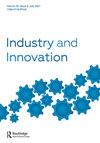Co-Worker complementarities and new firm survival
IF 4.2
3区 管理学
Q1 ECONOMICS
引用次数: 0
Abstract
ABSTRACT In the present paper, we analyse the association between the skill composition of young firms and the firms’ subsequent survival. This is made possible by means of a matched employer-employee dataset from Statistics Sweden on a cohort of firms that started between 2001 and 2003. Our findings show that, compared to firms that exit, the firms that survive at least until 2012 have teams with higher complementarity at the start, and successively increase their skill complementarity over time. Subsequent discrete time hazard models, controlling for several well-known determinants of firm longevity, show that complementarity plays a crucial role for firm survival. Higher skill synergy within firms, as compared to high degrees of substitutability, is associated with a lower conditional probability of failing. The role of skill complementarity is stable across different specifications and outweighs many other determinants of firm survival, such as starting size and experience of the founder.同事互补与新企业生存
摘要本文分析了年轻企业的技能构成与企业后续生存之间的关系。这是通过瑞典统计局对2001年至2003年间成立的一批公司的匹配雇主-雇员数据集实现的。我们的研究结果表明,与退出的公司相比,至少存活到2012年的公司在一开始就拥有更高的互补性团队,并且随着时间的推移,他们的技能互补性不断提高。随后的离散时间风险模型控制了几个众所周知的企业寿命决定因素,表明互补性对企业生存起着至关重要的作用。与高度的可替代性相比,企业内部较高的技能协同作用与较低的失败条件概率有关。技能互补性的作用在不同规格中都是稳定的,并且超过了公司生存的许多其他决定因素,例如初始规模和创始人的经验。
本文章由计算机程序翻译,如有差异,请以英文原文为准。
求助全文
约1分钟内获得全文
求助全文
来源期刊

Industry and Innovation
Multiple-
CiteScore
8.10
自引率
7.70%
发文量
41
期刊介绍:
Industry and Innovation is an international refereed journal presenting high-quality original scholarship of the dynamics of industries and innovation. Interdisciplinary in nature, Industry and Innovation is informed by, and contributes in turn to, advancing the theoretical frontier within economics, organization theory, and economic geography. Theoretical issues encompass: •What are the institutional underpinnings for different organizational forms? •How are different industrial structures and institutions related to innovation patterns and economic performance?
 求助内容:
求助内容: 应助结果提醒方式:
应助结果提醒方式:


